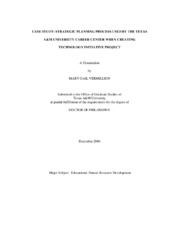| dc.description.abstract | There is a plethora of research and literature focusing on strategic planning yet there few case studies have been done that describe the strategic planning process for university career centers. No effective strategic planning guide has been written to assist career center employees with building a strategic plan that will assist in reaching all Texas A&M University students with job skills training. The purpose of this study is to give a detailed account of the strategic planning process used by the Texas A&M Career Center to create the technology initiative. The study will also provide guidance to the researcher and others who will be developing similar initiatives in the future. In an effort to assist career centers nationwide it would be helpful for those career centers to look at others, like Texas A&M Career Center, who have already begun the strategic planning process.
A descriptive case study design was chosen because it adds strength to what is already known and also helps explain complex issues. Case study research gives an in-depth contextual analysis of a limited number of events. The study of the planning process is very complex and case study research is one method that can be used to bring deeper understanding and add strength to what we already know about the planning process (Dooley, 2002). Following the lead of Rice (2002) a descriptive case study was chosen so that the researcher could describe the strategic planning process and interpret the findings in a way that would provide greater insight. Qualitative methods, including examination of documents, examination of journals, calendars and meeting notes, and interviews with a few members involved in the process to clarify any questions of memory, were used in this study. The study described the technology initiative and split the development into five stages: Conception, Birth, Toddling, Up and Running, and Adolescence (Rice, 2002).
The researcher has completed the descriptive case study and analyzed the data according to the planning approach continuum. A new model has been created that provide insight to the researcher and hopefully other planners. Recommendations and conclusions have been provided that will hopefully be beneficial to other planners. The descriptive case study provides a story that highlights good and bad planning techniques and the researcher hopes that others will read and learn from this study. The purpose of the study has been fulfilled. | en |


